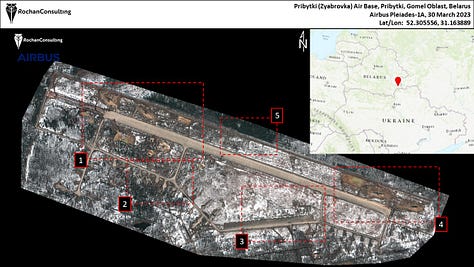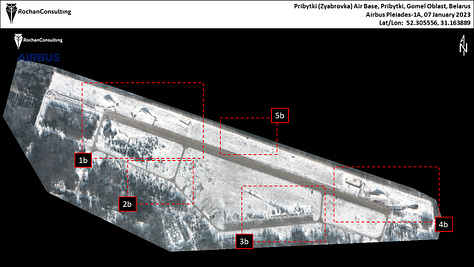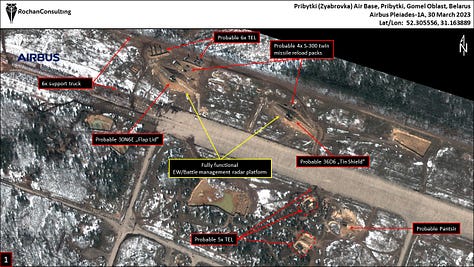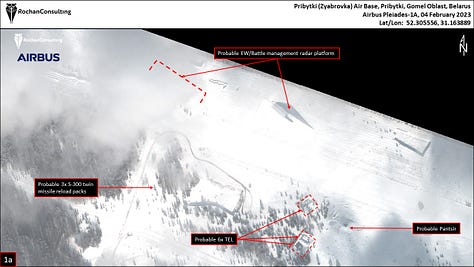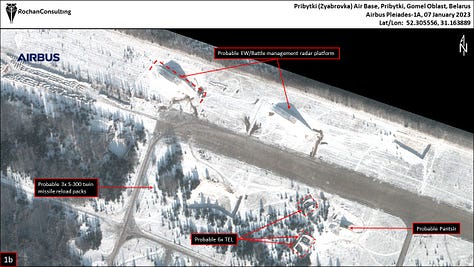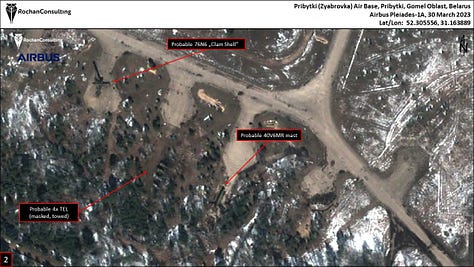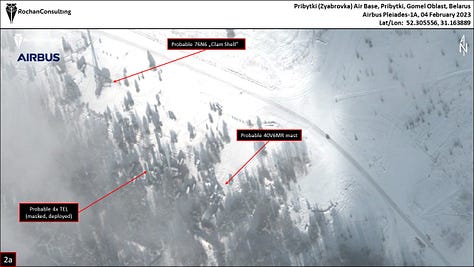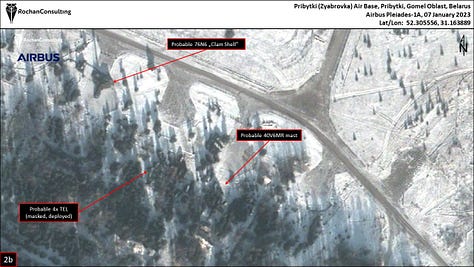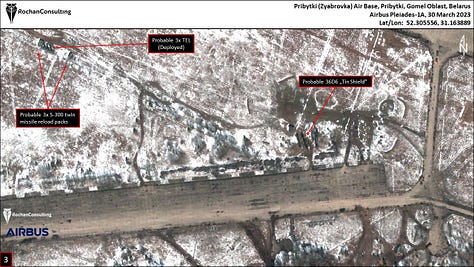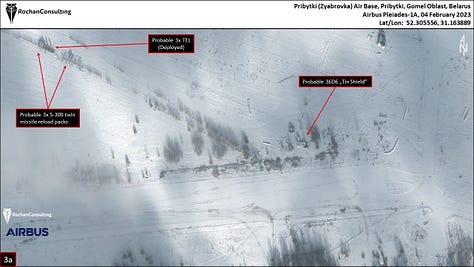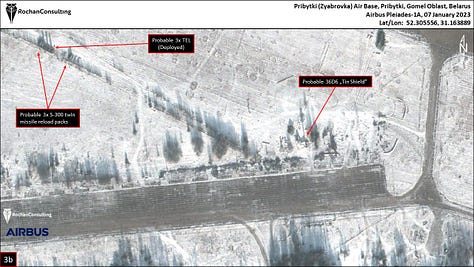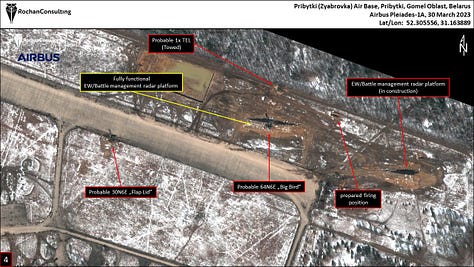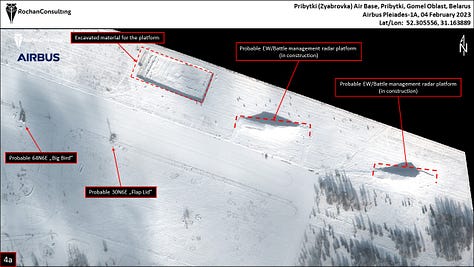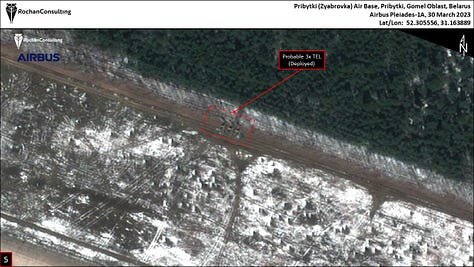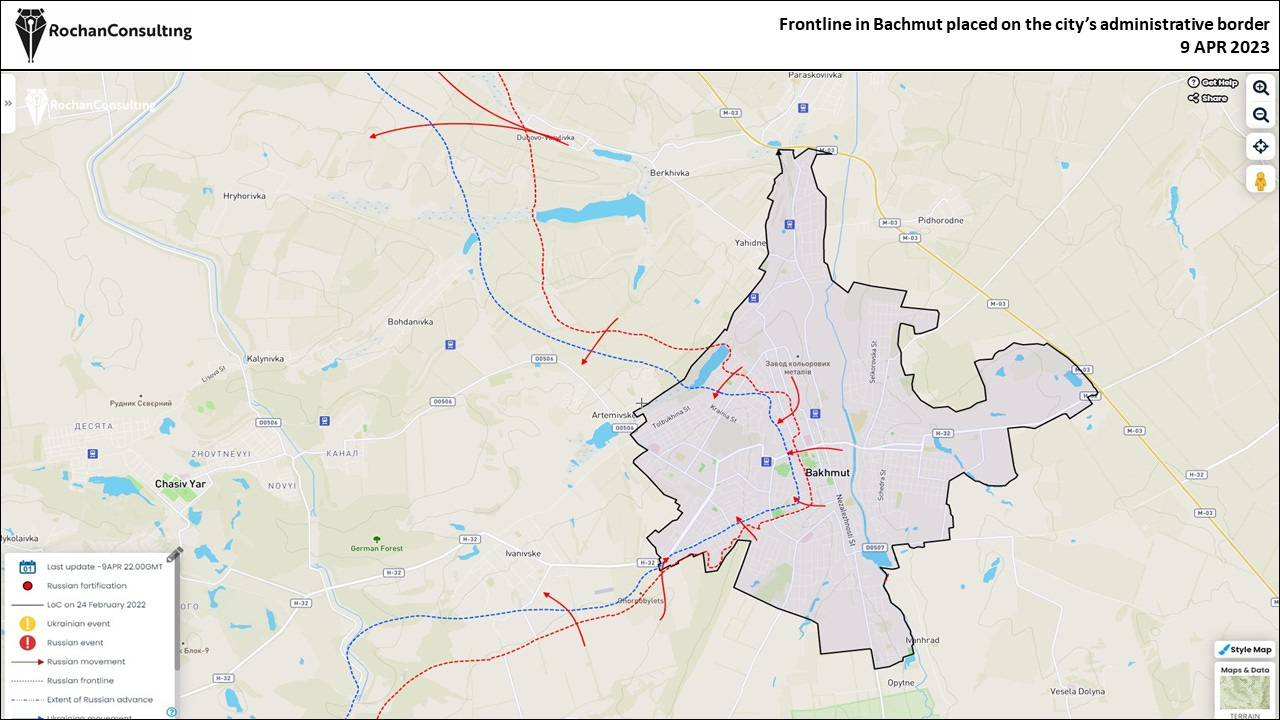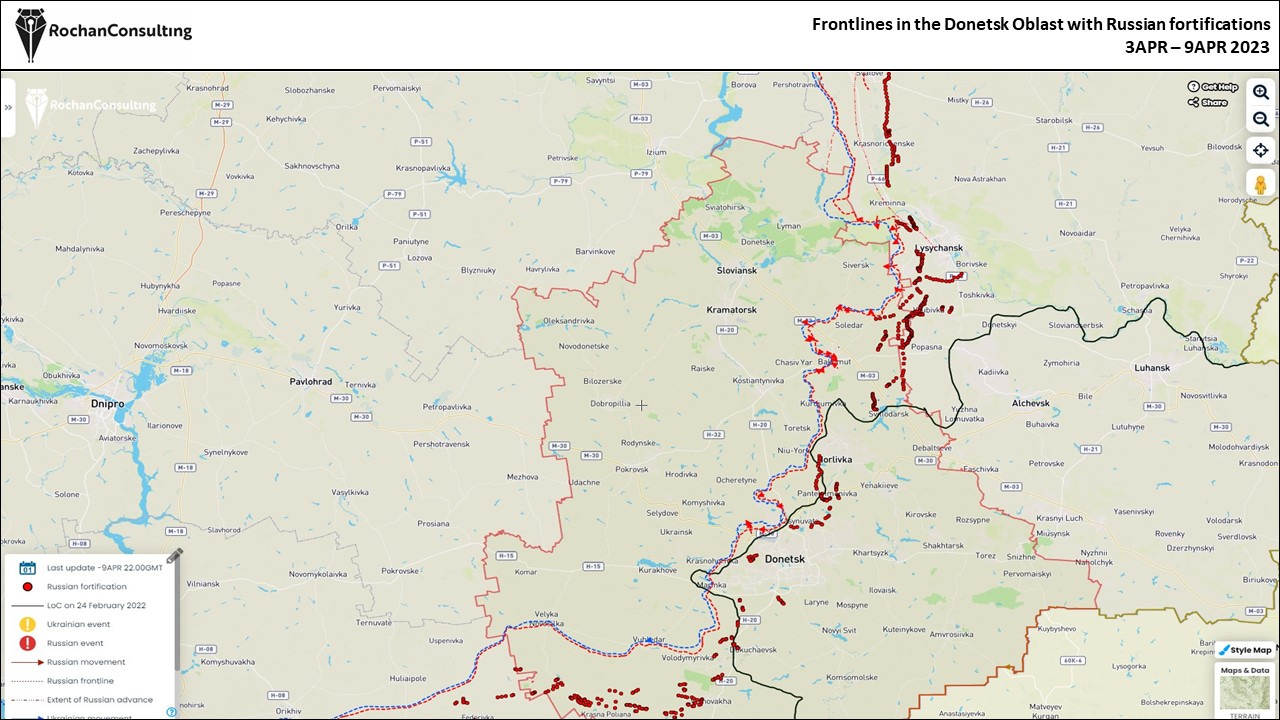Ukraine Conflict Monitor - 3 April – 9 April 2023 (Weekly update)
Situational report 3 April – 9 April 2023
Key takeaways from last week’s developments:
The frontline remained mostly static last week; Russians continued to progress in Bakhmut and may have made some tactical gains in the Donetsk Oblast; In other areas, Russian attacks were repelled;
The situation in the Kharkiv Oblast did not undergo any changes; Russians made no advances but continued to conduct heavy artillery strikes in the northern parts of the region;
Russians again made no gains in the Luhansk Oblast, despite the region having the biggest Russian force density in Ukraine as of early March;
Russians made no gain around Bakhmut last week, which means that flanks were stabilised, and the threat of encirclement no longer exists; On the other hand, the attackers made steady gains in the city, and they controlled more than 70 per cent of Bakhmut as of Sunday; Russian offensive potential in Bakhmut did not culminate last week;
Russians made no confirmed gains near Avdiivka, as all ground attacks were pushed back; The attackers employ around 10-20 glide bombs a day, which poses a new threat to Ukrainian forces;
Moscow may have extended territorial control near Novobakhmutivka, but without an impact on the overall situation in the area;
The situation in the Zaporizhihia Oblast remained stable, although some reports indicated possible Russian ground attacks; A notice calling for the evacuation of civilians from Berdyansk could have been a Ukrainian PSYOPS seeking to degrade OPFOR’s belief in their ability to hold the ground in the region;
No frontline changes occurred in the Kherson Oblast; Russians may have started reinforcing their presence in the region in anticipation of a Ukrainian counterattack;
The Belarusian Armed Forces began a readiness check, mostly centred around the 11th Mechanised Brigade, although other components were heavily involved in various exercises as well; A Iskander-equipped subunit departed to Russia for training, which will also include the use of nuclear warheads; We continue to see no major changes affecting the posture of the Belarusian military as a whole;
Satellite imagery analysis shows continued development of a S-300 air defence system site at the Pribytki Air Base in Belarus;

General outlook
We continued to see no major changes in Ukraine last week. Apart from Bakhmut, the frontline is deadlocked as neither side has the capacity to (or is presently able to) impose its own plan on the opposing forces. The war remains in its transitory phase while both sides await the Ukrainian counterattack.
There were a lot of rumours lowing around Russian sources last week suggesting that the Ukrainian attack would commence within days. We still think it is a bit too early for this Kyiv to commence its operations. Although, as the reader will see below, the weather is quickly getting warmer, mud is still the primary feature of the terrain across Ukraine. We assess that early May will probably open up a window of opportunity for Ukrainians, and actions before that will likely have a battle-shaping character.
The Battle for Bakhmut continued. While Ukrainians managed to stabilise the flanks around the city, their defences in Bakhmut started crumbling. As of Sunday and based only on confirmed visual evidence, Russians controlled more than 70 per cent of the city. We thus assume that, in reality, they held more and continued to push Ukrainians out towards the western parts of the city. As we warned last week, it was too early to claim that Russian potential in Bakhmut was exhausted or that its attacks culminated. Indeed, some Ukrainian commanders correctly characterised a relative lull in Russian attacks as regrouping and reinforcements. Russians do not appear to suffer from supply problems in Bakhmut, and the opposing force is not trained and equipped well enough to stall the attacks. The nature of Russian mission command in Bakhmut also does not pay special attention to the well-being of soldiers, so while some rotations could happen, we certainly cannot talk about formations being sent back from the frontline to decompress. The likelihood is high that Russians will continue ground attacks in Bakhmut until the city is fully taken. Only then will we be able to assess future Russian operations on this axis and Russian combat potential after this exhaustive fight. Alternatively, and
it is a low-likelihood event, if Moscow makes no gains in Bakhmut for two weeks in a row, we will probably assess that Russians are past the culmination point.
We continued to unsuccessfully track Russian units that were not combat-involved. Many factors could explain the lack of Russian progress in the winter offensive. We understand that not all available forces were deployed. We still do not know where the bulk of Central and Eastern Military Districts forces are stationed and what training they have been receiving. It is thus safe to assume that their training is ongoing, but it could end soon. Secondly, we assess that these forces form Moscow’s strategic reserve that would be deployed into areas that Kyiv decides to attack. If the Russian high military command learns from its mistakes (that’s not always the case), it will not repeat the same mistake it did in July-August 2022 when it left the eastern Kharkiv Oblast defenceless. Based on our conversations in Kyiv in March, we can confirm that Russians were fully aware of the impending Ukrainian attack. But they did not have time and available forces to reinforce this direction, resulting in the collapse of Russian presence once Ukrainians started moving. It is thus very plausible that mobilisation created a reserve component to strengthen parts of the front most threatened by Ukrainian actions.
As many of you probably know by now, the most important event related to Ukraine was the leak of classified US data on the war in Ukraine. We did not have an in-depth dive into the documents yet, but we still have some general observations.
Firstly, although the Department of Defense confirmed that documents posted online were real, let’s all remember this is a steal a leak. We don’t know why, how and to what end these documents were released. Secondly, let’s remember that a large part of these documents assessed the situation as of early March. This is especially important when examining claims about the imminent depletion of Ukrainian air defence missions. We can confirm an ammunition supply problem with one of the Western systems, which will unlikely be solved by now. However, estimates shown in these files were probably based on the tempo of the Russian air and missile winter campaign. In recent weeks, this tempo decreased significantly. In fact, the last large-scale attack occurred on 9MAR, which makes the past month the longest missile-attack-free period since Moscow began its campaign in October 2022 (previously, Russians would strike around every fortnight). Consequently, as the intensity of attacks decreased, Ukrainian stockpiles of missiles for all its air defence systems should increase or at least be preserved for longer.
Thirdly, it was interesting to see how Russian manpower was distributed across Ukraine. The documents claimed that there were 139,500 Russian (manouver?) forces deployed along the frontline. Out of this number, 48,600 were in the Kharkiv/Luhansk Oblast, 29,000 in Bakhmut (7,000 regular and 22,000 Wagner fighters), 23,050 were in the Donetsk Oblast, 23,350 in the Zaporizhihia Oblast, and 15,600 in the Kherson region. The concentration of forces in the Kharkiv/Luhansk Oblasts is interesting. On the one hand, it showed Russian determination to alter the frontline in the area, but also their continued inability to do so despite having the biggest concentration of soldiers per kilometer.
Weather forecast
(Lowest temperatures are for nights and highest for days unless otherwise stated)
This week will not deliver fundamental changes in weather in Ukraine. Temperatures will stay above 10°C (50°F) for the whole week, although nights can be chilly, with temperatures dropping to 4°C (39°F). Rain is expected in mid-week.
The weather in the Kreminna area will be stable. The temperatures will hoover around 15-17°C (59-62°F) for the whole week, but the temperatures during nights will decline as the week goes on, from 10°C (50°F) on Tuesday to 4°C (39°F) on Saturday. Light rain is expected between Wednesday-Friday.
The Bakhmut area will follow an almost identical pattern. The same temperatures are forecasted during days and nights. The main difference is that the rainy period will start on Tuesday, as opposed to Wednesday, as in Kreminna.
The Zaporizhzhia region will also experience warm weather this week. The peak temperatures will be around 15-17°C (59-62°F), but during nights they are not expected to drop 6°C (42°F) below on Saturday. Rain, however, is expected between Tuesday-Thursday and on Saturday.
While the 30-day weather forecast continues to show warm temperatures in Ukraine until the end of the month (they could reach 22°C (71°F) on 29-30APR), there could be a drop in early May to 9°C (48°F) during the day and 2°C (35°F). This cold spell is to be short-lived and is presently forecasted to last 3-4 days. After that, the temperatures will gradually rise to the low 20s in the second half of May.
The weather will continue to provide the warmth and stability needed for the ground to dry up and provide sufficient conditions for heavy armour movement. Videos (a different view on this tank) made on approaches to Bakhmut continue showing muddy roads, which hinder ground movements.
Summary of losses
According to the Russian Ministry of Defence, since the start of the war, Ukraine has lost 406 aircraft (+2), 228 helicopters (0), 3,641 UAVs (+120), 415 anti-aircraft missile systems (launchers?)(0), 8,593 tanks and other armoured combat vehicles (+83), 1,078 MLRS launchers (+1), 4,543 field artillery guns and mortars (+58), as well as 9,387 units of special military vehicles (+117).
According to the Ukrainian General Staff, Russia lost (eliminated) 178,150 personnel (+3,600), 3,636 tanks (+41), 7,024 armoured combat vehicles (+38), 2,740 artillery systems (+53) and 533 MLR systems (+6), 282 anti-aircraft systems (+3), 307 aircraft (+1) and 292 helicopters (+1), and 2,312 UAVs (+63), 5,602 vehicles and fuel tanks (+65), 911 cruise missiles (0), 18 warships and boats (0) and 309 (Numbers in parentheses denote a weekly change).
Military situation in Belarus
Last week brought several developments regarding the military situation in Belarus. They pertained to increased activities of the political-military representatives, an armed forces’ readiness check and an increased number of Russian transport aircraft landings in Belarus.
Over the past seven days, the Belarusian President was actively involved in the Belarusian military sphere. On Monday, he initiated the combat readiness check of the Belarusian Armed Forces. Specifically, the 11th Mechanised Brigade was put on alert and inducted dozens of reservists and equipment (trucks and excavators) from the national economy, probably to raise the unit’s manning to full strength.
A day later, Lukashenko met with the Head of the Russian Foreign Intelligence Service (SVR), Sergey Naryshkin. The Head of the Belarusian KDB (KGB), Lt. Gen. Ivan Tertel, also attended the meeting, mainly linked to the cooperation between Russian and Belarusian special services. Lukashenko noted that Russia and Belarus faced some “scumbags” who were often part of their societies and were working for other states. He added that they should not be considered as intelligence or counterintelligence collaborators but purely as enemies of the state. Belarusian leader also thanked Naryshkin for Russian assistance, especially regarding exchanging information and support in SIGINT activities. According to Lukashenko, the Russian Special Military Operation was a catalyst for assessing the capabilities of the Belarusian power ministries and prioritising their further development.
On Wednesday and Thursday, the Belarusian President went to Russia.
On day one, he met with his Russian counterpart, Vladimir Putin. Lukashenko spoke mainly about the realisation of joint Union State cooperation programs. According to him, the implementation of 28 cooperation acts started about two years ago was currently finished at about 80%. He also noted that frequent meetings of both presidents were often linked to the necessity of discussing specific issues and speeding up the integration process. Later, officials participated in closed-format talks related to security issues. They likely referred to the development of the military-industrial complex, as well as the defence of the Union State. No additional information about the latter meeting was published.
Lukashenko took part in the Supreme Union State Council board meeting on Thursday. He referred to the successful detainment of a Ukrainian saboteur, which was possible thanks to efficient KDB-FSB cooperation. The Belarusian leader underlined the necessity of creating a joint media holding. He continued that such an organisation was necessary to win the battle “for the minds and hearts” of the Union State citizens, especially now due to the ongoing confrontation with the collective West.
On the other hand, Russian President Vladimir Putin announced increased security cooperation between Russia and Belarus within the Union State security system, but it is unclear what this involves yet. The Supreme Union State Council meeting was also attended by the Secretary of the Belarusian State Security Council, Lt. Gen. Alexander Volfovich. He stated that the draft National Security Concept for the Union State would be prepared for approval at the analogical gathering in 2024.
Subsequently, the Secretary of the Belarusian State Security Council, Lt. Gen. Alexander Volfovich, informed that the draft National Security Concept for the Union State will is prepared for approval in 2024.
When it comes to personnel changes, on Monday, Belarusian Minister of Defence, Lt. Gen. Viktor Khrenin, officially introduced Col. Vladimir Bely as the new Commander of the Western Operational Command. According to Khrenin, Bely served in key positions in the North-Western Operational Command and Special Operation Forces, allowing him to lead the troops and bring them to a new level of training.
Regarding international events, the Deputy Minister of Defence for the Ideological Work, Maj. Gen. Leonid Kasinsky took part in a joint meeting of the Commonwealth of the Independent States (CIS) Personnel Committee and involved ideological representatives from Armenia, Kazakhstan, Kyrgyzstan, Tajikistan, Uzbekistan, and Russia. The event is held annually, but this year it took place in Belarus and pertained mainly to the measures to counter contemporary manifestations of neo-nazism.
One international event occurred on Friday. The Head of the Main Directorate for the Combat Training, Maj. Gen. Alexander Bas participated in the visit of Belarusian and Russian journalists to the Lepelsky Training Ground. Bas stated that the combat preparation of the Union State grouping was a crucial task set by the Belarusian President. Currently, more than 500 Belarusian instructors provide training to Russian soldiers stationed in Belarus. Training programmes are reportedly based on experiences gained from the Russian “Special Military Operation” in Ukraine. As noted by Bas, the course of the Russo-Ukrainian conflict was actively analysed and caused corrections both In individual and subunit training programs.
We can also note that the Head of the International Military Cooperation Department, Col. Valery Revenko, met with the Ambassador Extraordinary and Plenipotentiary of the Syrian Arab Republic, Mohammad Al–Umrani. According to the official statement, the Syrian side initiated the meeting to express gratitude for the Belarusian support after the latest earthquakes. It referred to the deployment of the Belarusian military field hospital, which provided medical assistance to more than 3,000 Syrians. The meeting was also used to discuss bilateral military relations.
Last week, the combat readiness check of the Belarusian Armed Forces was undoubtedly the main training event. From the ground forces perspective, the drill mainly pertains to the 11th Mechanised Brigade, which has probably been (or will soon be) reinforced with 1,500 reservists. The brigade has a manning level of around 2,500 men, so an additional 1,500 would bring the unit to full strength. Interestingly, the Belarusian Hajun project published material suggesting that Belarusian Military Commissariats of the mentioned regions knew about the “unexpected” inspection about a month before it was announced.
Also, last week, Belarusian service members (from the Iskander subunit) of the 465th Missile Brigade left for Russia. Officially, they will undergo a full training cycle at one of the local training grounds, including using tactical nuclear warheads.
Besides, the Belarusian Air Force and Air Defence Forces started their own command-staff training on Tuesday. It lasted two days directly under their commander, Col. Andrey Lukyanovich. The exercise tested planning and using the Belarusian air component as a part of the Joint Union State Grouping.
Moreover, several units and subunits carried out standalone field exits combined with practical training actions. It refers to the 10th Electronic Warfare Battalion (Monday), elements of the 111th Artillery Brigade (Tuesday-Thursday), 339th Mechanised Battalion of the 120th Mechanised Brigade (Wednesday), as well as the 48th Electronic Warfare Battalion (?-Thursday) and Special-Purpose Medical Detachment of the 432nd Main Military Clinical Medical Center (Friday).
Moreover, 358th Mechanised Battalion (120th Mechanised Brigade) was involved in a company-level tactical exercise on Tuesday, while the 115th Air Defence Regiment started its tactical exercise a day later. The latter exercise also involved elements of the 38th Air Assault Brigade on Thursday. Training actions were also observed among communications formations. It refers to the 60th Communications Regiment (Monday) and the 86th Communications Brigade involved in the special-tactical exercise on Thursday.
Over the past seven days, the amount of Belarusian military equipment observed on the move was much higher than in previous weeks. Observed were military echelons transporting mechanised equipment of the 120th Mechanised Brigade (Wednesday-Thursday), artillery assets of the 191st Artillery Group (Friday) and unspecified tanks (Saturday). Notably, more specialised vehicles such as MAZ-537 and MAZ-6424, as well as TMM-3 bridges and BRDM-2s, were also seen throughout the week. Unofficial sources also reported movements of air defence assets, including a single Tor-M2K launcher (Tuesday) and an OSA system (Thursday).
The activity of the Russian forces was also notable. To start, two Russian Su-30SM and MiG-31s reportedly left Belarus. But, on the other hand, seven An-124 heavy transport aircraft made 12 visits to Belarus last week. We do not know what this increased activity was related to. The ground movements were relatively small, although two Russian echelons were seen in the country. The first one, with about 30 unspecified guns, was seen on Tuesday, while the second, with about 30 BMPs/BTRs, entered Belarus on Saturday.
Please click here to access the list of Belarusian training activities since the start of the year.
The situation at selected axes and directions
Kharkiv direction
As expected, last week did not deliver any changes in the Kharkiv Oblast. The frontline remained deadlocked, and no evidence suggests that either side has the capacity to turn the tide in this part of Ukraine.
Positional battles continued to occur near Hrayanykivka, Masiutivka and Krohmalne, but all Russian attacks were repelled in these areas. No Russian ground attacks occurred from Russia proper last week.
We understand that Ukrainians conducted no ground offensive actions apart from some tactical attacks. A small report early in the week suggested that Russians were dislodged from positions near Hranykivka. We could not confirm this development.
Russians continued to conduct artillery and missile (S-300) strikes, mostly on civilian targets throughout the region. Last week, they primarily targeted Kupyansk, Vovchansk, Veterynarne, Ohirtseve, Vilkhuvatka, Dvorichna, Kucherivka, Udy, Liptsi, Dovhenke and Kozacha Lopan, Hatyshche, Velykyi Burluk, Strilecha, Pishchane Ohirtseve and Krokhmalne. On Sunday, a Russian missile fired from an S-300 air defence system hit an agricultural enterprise in Veliky Burluk.
A video was shared online by Ukrainians reportedly showing Ukrainian artillery strikes on Russian military positions in Russia proper. Ukrainians regularly shell Russian positions in the Belgorod Oblast, although this subject rarely makes it to the press. It is unclear how effective these strikes are and to what extent Ukrainians manage to degrade Russian ability to strike their territory or interdict the movement of Russian forces near the state border.
Luhansk direction
Last week did not deliver any frontline changes in the Luhansk Oblast, despite the region having the highest density of Russian forces in Ukraine and the Lyman direction being the most often artillery-struck sector in Ukraine. Without opening up a second axis of attack towards Slovyansk, Russian plans to capture the remaining parts of the Donetsk Oblast will be very difficult to materialise.
Last week, the bulk of military activity occurred between Ploshchanka – Bilohorivka line. Looking at specific settlements in the region, Russians made no confirmed progress near Stelmakhivka, Novoselivske and Kuzemivka and Makiivka, Ploshchanka and Chervonopopivka.
Ukrainian bloggers claimed on Tuesday that Russians intensified “storming operations” near Novoselivske – Kuzemivka. They also marked limited Russian progress near Novoselivske, but this reported success had no impact on the frontline.
Russians conducted several attacks near Torske and Nevske, but neither Russian nor Ukrainian sources reported any changes in this part of the frontline. It is thus safe to assume that all attacks were repelled.
The Kreminna area mostly saw positional battles. No changes were reported in the Serebryansky forest and near Dibrova. On Tuesday, a Ukrainian source claimed that Russians conducted offensive actions south of Dibrova. They used armoured vehicles to support the assault and were seen progressing in some places, but no confirmed gains were made.
On Monday, Ukrainian bloggers claimed that south of Dibrova, Russians concentrated a significant number of artillery pieces. A day later, Serhiy Cherevaty, the Eastern Group of the Ukrainian Armed Forces spokesman, stated that Russians did not experience shell hunger in eastern Ukraine, despite various reports on the subject. He added that the Lyman direction (Kremmina area) is the heaviest-shelled area in Ukraine. Serhiy Cherevaty provided some interesting data on the scale of Russian and Ukrainian activities. On 5APR alone, Russians fired 399 times at Ukrainian positions and launched five ground attacks. Twenty-eight Russian servicemen were killed, and 62 were wounded. A T-72 tank, an armoured personnel carrier, a 2S4 Tyulpan 240 mm self-propelled heavy mortar and, a K-52 helicopter also were destroyed. Oleksiy Smirnov, the interim acting head of the Luhansk regional military administration, said that Russians conduct daily artillery attacks on firing settlements along the frontline. However, he explained that when in 2022, Russians could fire almost continuously along the entire contact line, now they concentrate their fires only on specific targets. Smirnov added that this change occurred due to the accuracy of Ukrainian artillery fires and attacks on the Russian rear.
Ukrainians, on the other hand, experience shell hunger. A Ukrainian journalist stated that Ukrainian forces had to ration artillery in preparation for the upcoming offensive.
On Monday, a video on Telegram reportedly showed personnel of the 98th Airborne Division fighting in the Serebryansky forest. The unit is also supporting Wagner’s operations in Bakhmut. The deployment of one unit, even as large as an airborne division (the division had around 6,000 men pre-invasion) in two different areas is unusual. The deconcentration of the 98th Airborne Division efforts highlights two things: Firstly, Russians are confident that currently deployed forces in Bakhmut are sufficient to capture the city. Secondly, Russians are not confident that its regular army formations are capable of making territorial gains. We understand that airborne units are prioritised when it comes to deliveries of new equipment. Some units were already seen operating T-90 MBTs. The weekly update also noted that they would soon use TOS-1 heavy flamethrower systems to clear buildings, field fortifications and bunkers. The only question is whether Russians can deploy a sufficient number of systems to make a difference on the battlefield. The TOS-1 was suspiciously absent from the battlefield lately, highlighting problems with its employment.
A Ukrainian analyst stated on Friday that one of Russia’s motorised rifle units was reinforced with 12 tanks, including T-72s, T-80s and even T-90. The source claimed that the unit had no crews who could operate these tanks. He added that the shortage of professional crews is becoming as acute a problem as the shortage of “modern” tanks. In turn, the T-62 and T-54/55 are quicker and easier to remove from storage, and it takes less time to train them.
No changes were reported in the Bilohorivka area. All Russian attacks were repelled. A video on social media showed soldiers from the Ukrainian 81st Airmobile Brigade firing an ATGM on a Russian tank near Bilohorivka.
Ukrainians reportedly fired four missiles from a HIMARS on Troits’ke, hitting residential buildings, a hospital, and a store. Another not dated strike reportedly hit a Russian command post in Kuzemivka.
Donetsk Oblast Direction
Last week, the only area where Russians made confirmed gains was in Bakhmut. All other changes (literally two) were reported and not visually confirmed.
Starting from the northern parts of the Donetsk Oblast, Russian attacks on Spirne and Verkhokamyanske failed to deliver any gains. The same pertains to Vesele, Rozdolivka and Vasiukivka.
Last week we stated that the Russian offensive potential near Orikhovo-Vasylivka and Min’kivka “completely petered out”. This prognosis was correct. Russians made no gains in areas north of Bakhmut as all efforts focus on capturing the city.
We were also correct in stressing that it was too early to call the culmination of Russian attacks in Bakhmut or that the city’s defence was a success, as Western and Ukrainian media reported. Last week confirmed in emphasis that the Russian culmination never occured as the attackers made steady gains in the city. Early in the week, they captured the city administration building and the Bakhmut-1 rail station, and by the end of the week, the entire central part of the town was under Russian control. The increase in the number and tempo of Russian attacks was confirmed by a Ukrainian soldier who claimed said the Wagner PMC ammunition hunger was over. He stated that Russians doubled the number of artillery strikes on Bakhmut and sent whole assault squads into the city, while the dead were being replaced with new men during battles.
On Sunday, pro-Russian sources claimed that Russians reached the main central station in Bakhmut.
A presumably Ukrainian soldier published a video on social media saying that the Ukrainians would soon conclude the period of defence in Bakhmut and would launch a counterattack. They are just waiting for the ground to dry. Based on last week’s trajectory of events and weather forecasts, it seems unlikely that Ukrainians will be able to hold the city so long as the ground dries up.
Indeed, the Russian fire pocket in Bakhmut is getting increasingly smaller, which makes it more difficult for Ukrainians to defend. Ukrainians are increasingly squeezed, and without a counterattack, their pullback from the city is a realistic possibility. That said, we should also note that while in Poland, Volodymyr Zelensky, the President of Ukraine, characterised the situation in Bakhmut as very difficult. Nevertheless, the decision to withdraw from the city will only be made in case of mounting manpower losses, he added.
As of Sunday, Ukrainians controlled 29 per cent of Bakhmut (only confirmed gains).
Ukrainian bloggers asserted that Russian offensive potential along the Kostyantynivka-Bakhmut line was disrupted by regular Ukrainian attacks on ammunition depots in Klishchiyivka, the main Russian rear hub. Russians made no progress in this area last week, so we assume that Ukrainian defensive operations were successful.
Moving further south, only small, unconfirmed frontline changes were reported in the remaining parts of the Donetsk Oblast. Specifically, Ukrainian bloggers noted that Russians improved their positions slightly west of Novobakhmutivka, where they cut off a part of the rail line and near Novoselivka. Throughout the whole week, Russians tried to advance towards Keramik. On 5APR, a source claimed that Russians captured several new positions near the village. Ukrainian sources did not report changes in this area but claimed that the Russians continued to mobilise its reserves for assault operations on the northern flank of the Avdiivka axis. Russian missiles also struck Ukrainian rear areas to degrade Kyiv’s ability to defend areas around Avdiivka.
Russians also continued to attack Ukrainian positions south and east of Avdiivka. Various Russian sources claimed throughout the week that attacks have a combined-arms character and involve artillery and aviation. However, despite this, Russians did not inch closer to the city from east and south.
According to Colonel Oleksiy Dmytrashkivskyi, Ukrainian Tavriisk Direction Forces Joint Press Center Spokesperson, the number of Russian attacks near Avdiivka and Mariinka decreased compared to March. On average, Russian aircraft carry out 10-15 air attacks daily, and the number of artillery attacks varies – closer to weekends, the Russians usually experience shell hunger and a shortage of personnel. Because of this, the Russian command is forced to constantly deploy additional troops to the front line, including Russians trained at Belarusian training grounds. He added that last week, 4,000 Russians were killed, and these losses would be replenished by personnel trained in Belarus.
The last comment needs an explanation. In Belarus, Russians trained the 2nd Motor Rifle Division units, including the 147th SPH Regiment and 1st and 15th Motor Rifle Regiments. The total number of Russian personnel trained in Belarus exceeded 4,000 men (probably around 10,000). Moreover, these forces left Belarus last month, and we are unsure where they are currently deployed. They have not been sent to the front, this is clear. Our best (educated) guess is that they either station in the Luhansk Oblast or near the border on the Russian side. They also likely contribute towards the Russian strategic reserve to be used in a contingency scenario.
Another aspect of Russian operations we must highlight is the increased use of glide bombs. The speaker of the Air Force Command of the Armed Forces of Ukraine, Colonel Yurii Ihnat, noted on Tuesday that Russian Su-34s and Su-35s drop 10-20 glide bombs a day on Ukrainian positions. We claimed that they were deployed around 70 km from the designated target area, which means they are out of the reach of Ukrainian air defence assets. To address this threat, Ihnat noted, Ukraine needs long-range air defences, such as Patriots, and more combat aircraft, such as F-16s, to conduct counter-air missions.
Russians may have progressed towards Pervomaiske, but Russian assertions from two weeks ago about the fall of the settlement were undoubtedly untrue. Nevertheless, Russians were very active south of Avdiivka, but the reported advances did not impact the overall operational situation in the sector. Russians continue to be too weak to make an operational breakthrough south of Avdiivka, and occasional territorial gains come at high manpower and equipment costs.
Operationally, nothing has changed near Mariinka. Russians continued to press entrenched Ukrainians in the western parts of the settlement but did not manage to dislodge them. The tactical situation is vague. Some Russian sources claimed Russians made progress, but early in the week, Ukrainians claimed that Russians had been pushed back from the city’s southern districts and east of Pobieda. Another Russian source confirmed this change. A Russian Su-25 was reportedly shot down near Mariinka. But again, we are looking at tit-for-tat attacks, positional battles that do not impact the overall operational assessment.
No changes were reported near Vuhledar. The status of Russian operations near this is visibly reduced, and we expect no changes in this regard.
According to Colonel Oleksiy Dmytrashkivskyi, Ukrainian Tavriisk Direction Forces Joint Press Center Spokesperson, the large movements of Russian equipment were connected to logistical problems in the Donetsk Oblast and frequent Ukrainian missile strikes on Russian rear areas, including in Mariupol. He added that Russians were also preparing for active defence and strengthening their positions in the Zaporizhzhia region and Crimea. He also asserted that the activity of Russian forces in the Zaporizhzhia direction was almost down to zero, contrary to field reports (see below). He assessed that the chances for Russians to open a new axis of advance in the Donetsk region would be very difficult due to the heavy losses sustained near Vuhledar. He added that the 155th Naval Infantry and 200th Motor Rifle Brigades were already withdrawn from the front line to be reconstituted.
Zaporizhzhia direction
Last week did not deliver any events that would change the frontline situation in the Zaporizhihia Oblast. Artillery exchanges remained the primary mode of warfare.
Indeed, a Ukrainian source claimed that Ukrainian artillery destroyed a truck with Russian troops near Nesteryanka and Mali Scherbaky. Also, the source stated that the UAF approached Nesteryanka and liberated some territory near the village. The official Ukrainian sources did not provide information to confirm this development. Russian sources also did not report changes in the region. We were also not able to verify its veracity throughout the week.
Russians, on the other hand, reportedly launched an attack on Ukrainian positions near Hulyaipole from the Dorozhnyanka side. They managed to advance along the road towards the city. The Ukrainian source claimed that they progressed about 800m along the road. Nevertheless, the overall impact on the tactical situation in this particular sector was minimal. Russians also did not follow this on with additional attacks, and no further territorial gains were made.
However, from our point of view, the most important development occurred in Berdyansk. An image was posted on Telegram showing an evacuation notice to civilians urging them to leave the city by 15APR due to intensified hostilities.
We have not been able to confirm the authenticity of this notice. However, the closer we are to the offensive, the more such messages we expect to see. They could be part of Ukrainian PSYOPS seeking to cause panic among Russians in occupied territories. Such an approach partly worked during the Kharkiv Offensive, where high-mobility special forces detachments were pushing forward as fast as possible while Ukrainians on Telegram channels were spreading not-always-accurate information about areas being liberated. Surely, Ukrainians passed through them, but this did not equal liberation. This gave an impression of a swift movement of Ukrainian forces, which were much smaller than the Ukrainians made it out to be.
We need to add that Russians denied the notice was real, adding it was a Ukranian PSYOPS.
Berdyansk is some 90 km from the frontline. If the notice is real, the announced evacuation of civilians does not speak well of Russian belief in their ability to hold the ground in the Zaporizihihia Oblast.
Kherson direction and Crimea
We continued to see no changes in the Kherson direction last week. Both sides limit their operations to artillery strikes and reconnaissance missions on the Dnipro delta islands.
For the past few weeks, Ukrainians have been detecting and engaging Russian artillery systems on the Dnipro’s left bank. Officially, these efforts seek to limit Russian artily strikes on populated areas in Ukraine-controlled territory. However, pushing Russia’s artillery positions 20-30 km from the river would also be beneficial should Kyiv decide to conduct a river crossing operation in the Kherson Oblast.
Indeed, Nataliya Humenyuk, the United Coordination Press Center of the Southern Defense Forces, claimed on Thursday that Ukrainian strikes had already reduced the number of artillery positions from which Russian forces run their strikes.
On Wednesday, she stated that Ukrainians had managed to dislodge Russian troops from the Kinburn Spit.
Russians also continue to exert pressure on Ukrainian civilians living under Russian occupation in the oblast. Two weeks ago, we noted that the occupation administration warned locals that anyone who refused to accept rubbles or attempted to sabotage its use in the region would face criminal prosecution.
Last week, Serhiy Khlan, the Kherson Oblast Military Advisor, noted that those locals who have not taken a Russian passport have their movement and access to services restricted.
Khlan also reported that Russian occupation authorities offered voluntary evacuations to Ukrainians living in Skadovsk to Crimea or Russia. Volodymyr Saldo, the Kherson Oblast occupation administration Head, denied Khlan’s report about evacuation from Skadovsk and claimed that Russian forces were discussing plans to seize the right bank in Kherson Oblast. So far, we have seen no indications that Skadovk is being evacuated. As stated above, such comments are part of Ukrainian PSYOPS and battle-shaping efforts.
Russians, too, are preparing for the Ukrainian spring offensive in the Kherson Oblast. The Ukrainian General Staff claimed on Wednesday morning that Russians restricted the movement of civilians in Velyka Kardashynka due to the movement of “heavy machinery”. Entry and exit from the settlement were forbidden, and locals could not leave their homes. Russians also increased the verification efforts of the locals, who are often searched, and their phones are checked. We assess that the strengthening of Russian security measures is linked to the deployment of additional forces and/or pieces of equipment into the area and their concerns about the information on their dispositions being passed to Ukrainians.
We foresee no significant changes in this direction next week. However, the increase of Ukrainian PSYOPS against Russians in southern Ukraine is noteworthy. We expect Ukrainians to continue to pursue, or even accelerate, this campaign of trying to influence Russian decision-making processes until the counteroffensive begins.
Outlook for the week of 10APR-16APR
In assessing the probability or likelihood of certain events, we use a set of terms proposed by the US Intelligence Community.
We have decided to introduce more accountability to our forecasts. Therefore, each weekly update assesses how correct (or incorrect) our predictions were. Here is what we said last week. Please also remember that while we try to remain as objective as possible regarding our performance, the reader will ultimately have to decide how (in)accurate we have been.
Last week’s forecast
“We expect to see no changes in the Kharkiv Oblast. Russians will certainly continue to conduct daily artillery strikes on Ukrainian military and civilian targets across the region, while ground attacks will be limited and are highly unlikely to deliver any changes.” This forecast was correct.
Score: 1/1
“Events that unfolded in the Luhansk Oblast give very little room for optimism for the Russian side. Despite conducting (reduced) ground attacks across the entire frontline, Russians have been unable to capture one village or more for months. Last week saw a continuation of this trend. We continue to see no indications that any reinforcements have been deployed to the region, which supports our assessment that Russians are highly unlikely to extend their gains (one settlement and more) this week.” Russians made no progress in the Luhansk Oblast last week, despite the reportedly increased tempo of artillery attacks.
Score: 1/1
“The same pertains to the Kreminna area. While some tactical shifts may occur, chances are still remote that Russians will achieve a breakthrough in this sector.” This prognosis was also correct.
Score: 1/1
“When it comes to the broader Donetsk Oblast, we are looking at two main areas where Russians could progress: Bakhmut and Avdiivka. Their chances of making territorial gains in other parts of the region are very limited due to a lack of manpower, equipment, and shell hunger. As such, it is unlikely that Russians will progress in other areas apart from Bakhmut and Avdiivka.” Russians reportedly made progress near Novobakhmutivka and Novokalynove, but no visual evidence was presented to confirm the frontline change.
Score: 1/1
“Last week, Russians did not progress in areas around Bakhmut, both north and south of the city. Russians appeared to have shifted their capabilities from Khromove, Ivanivske, or in areas further north such as Orikhovo Vasylivka or Vasyukivka and Rozdolivka. Their forces deployed in these locations are tasked with fixing Ukrainian units, while most Russian efforts are firmly set on capturing Bakhmut, where Russians made some gains. Despite various reports appearing in Western media and analytical centres suggesting that Russian offensive potential has culminated, we assess that Russians will likely continue to make steady gains this week. Despite heavy losses, we assess that it is unlikely that Ukrainians will leave Bakhmut this week.” These views contrasted most of what was being said two weeks ago in various analytical centres. And we are happy to have been right in this case. Russians made relatively large gains last week in Bakhmut and continued to push west. Ukrainians, despite steep losses, did not withdraw from the city. We continue to see no indications suggesting that Russian attacks in Bakhmut culminated.
Score: 1/1
“Regarding Avdiivka, Russians will highly likely continue conducting ground attacks on Ukrainian positions near Avdiivka. But there is roughly even chance they will make tactical progress of capturing one village or more.” We were also correct here to foresee a decreased probability of Russian gains near Avdiivka last week (two weeks ago, we stated that it was likely that Russians would advance in the area). Russians made no gains near the city last week.
Score: 1/1
“We do not foresee any major changes in the Zaporizhzhia Oblast. Positional attacks will almost certainly continue. Ukrainians will likely start conducting more ground attacks this week.” This assessment was half-correct. On the one hand, no major events occurred in the oblast last week, but we saw no evidence to indicate that the tempo of Ukrainian ground attacks increased.
Score: 0.5/1
“We forecast no changes in the Kherson Oblast. River infiltration operations from both sides will continue, but without an impact on the frontline. Both sides will certainly conduct artillery strikes across the Dnipro River.” This assessment was correct.
Score: 1/1
“We expect no changes in the posture of the Belarusian Armed Forces (BAF) and Russian units deployed to Belarus. Chances are remote that Russians will attack Ukraine from Belarus next week.” This prognosis was also correct.
Score: 1/1
Final score: 8.5/9 (94%)
Next week’s forecast
We expect to see no changes in the Kharkiv Oblast and will thus retain last week’s assessment. Russians will certainly continue to conduct daily artillery strikes on Ukrainian military and civilian targets across the region, while ground attacks are highly unlikely to deliver any frontline changes
We also do not expect to see any changes in the Luhansk Oblast, including the Kreminna area. We have seen no indications suggesting the deployment of reserves into combat, and without them, Russians are unlikely to progress further.
When it comes to the broader Donetsk Oblast, we assess that it is unlikely that Russians will progress near Avdiivka. It is highly unlikely that they will advance in other areas within the region, Bakhmut excluded.
Regarding Bakhmut, it is unlikely that Russians will progress in areas north and south of the city. But, Russians will highly likely advance within the city’s limits and continue to push Ukrainians out. But last week’s tempo is maintained, we still think it is unlikely that defenders will withdraw. However, as we stated many times before, the decision to defend the city is political, making any assessment about the Ukrainian “will” to defend the city very difficult to make. If Zelensky changes his mind, the pullback to Chasiv Yar could be abrupt.
appeared to have shifted their capabilities from Khromove, Ivanivske, or in areas further north such as Orikhovo Vasylivka or Vasyukivka and Rozdolivka. Their forces deployed in these locations are tasked with fixing Ukrainian units, while most Russian efforts are firmly set on capturing Bakhmut, where Russians made some gains. Despite various reports appearing in Western media and analytical centres suggesting that Russian offensive potential has culminated, we assess that Russians will likely continue to make steady gains this week. Despite heavy losses, we assess that it is unlikely that Ukrainians will leave Bakhmut this week.
We do not foresee any major changes in the Zaporizhzhia Oblast. Positional attacks will almost certainly continue. Ukrainians will likely start conducting more ground attacks this week.
We forecast no changes in the Kherson Oblast. River infiltration operations from both sides will continue, but without an impact on the frontline. Both sides will certainly conduct artillery strikes across the Dnipro River.
We expect no changes in the posture of the Belarusian Armed Forces (BAF) and Russian units deployed to Belarus. Chances are remote that Russians will attack Ukraine from Belarus next week.
Satellite imagery analysis
*!!!IMAGES BELOW CAN NOT BE SHARED PUBLICLY!!!*
Pribytki (Zyabrovka) Air Base, Pribytki, Gomel Oblast, Belarus
Airbus imagery acquired 30 MAR shows western and one of the eastern EW/Battle management radar platforms are fully functional and used by EW/Battle management radars compared to Airbus imagery acquired 04 FEB and 07 JAN.
New stations were built for 6x TELs in the western part of the air base. The same area also sees the construction of an additional TEL site.
Compared to previous imagery, the number of deployed TELs increased by six, EW/Battle management radars by two and twin missile reload packs by one. Their stationing positions also changed.
Last month, the Belarusian MoD announced plans to set up a new air defence regiment in Pribytki. It is thus highly likely that what is currently deployed there are parts of the new unit.
